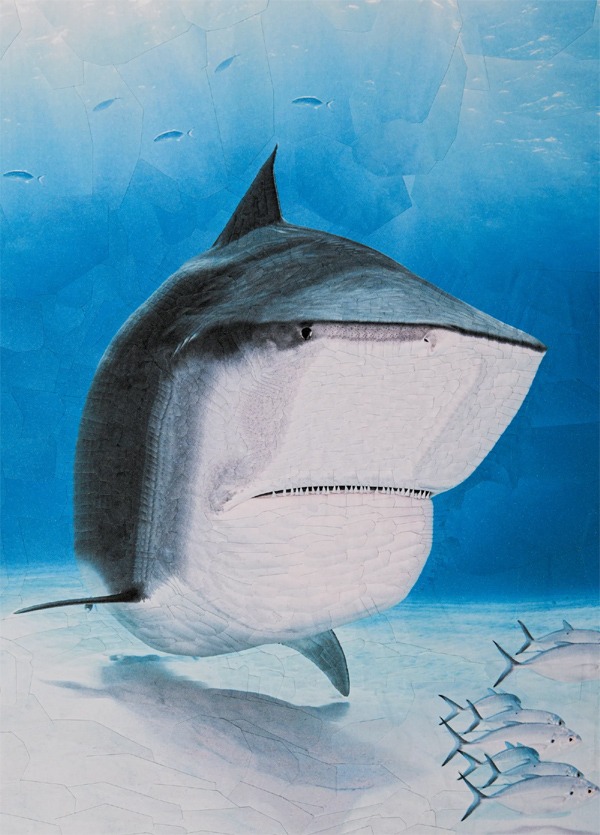Our nightmares may be haunted by circling dorsal fins—but there’s something more sinister happening below the surface of the sea.

By Katherine Rundell
One of the earliest written accounts of a man being eaten by a shark is also the account of a shark in love. It appears in “History of the Wars,” an eight-book chronicle by Procopius of Caesarea Palaestinae, born around 500 C.E. Composed under the censoring eye of the Emperor Justinian, the work is mostly so dry that it would be easier to eat than to read. But among the encomiums on war is the tale of an oyster “swimming not far from the shore.” According to Procopius, “Both its valves were standing open and the pearl lay between them, a wonderful sight and notable, for no pearl in all history could be compared with it at all, either in size or in beauty.”
As the oyster swam (Procopius does not seem entirely clear on how an oyster moves, and imagines it flapping like a butterfly), a shark “of enormous size and dreadful fierceness, fell in love with this sight and followed close upon it, leaving it neither day nor night; even when he was compelled to take thought for food, he would only look about for something eatable where he was, and when he found some bit, he would snatch it up and eat it hurriedly.” Then “he would sate himself again with the sight he loved.”
A fisherman, Procopius writes, reported the pearl’s existence to Peroz I, the King of Kings of Iran. Peroz—a man who depicted himself on three different coins with three different crowns, and surely enjoyed a glistening accessory—begged the fisherman to procure it for him. The fisherman waited, “watching for an opportunity of catching the pearl alone without its admirer.” When the shark was distracted by some edible morsel, the fisherman dived for the oyster: “He had seized it and was hastening with all speed to get out of the water, when the shark noticed him and rushed to the rescue. The fisherman saw him coming, and, when he was about to be overtaken not far from the beach, he hurled his booty with all his force upon the land, and was himself soon afterward seized and destroyed.”
How much of this is true? Almost none, of course; the only recorded relationships between sharks and oysters are gustatory rather than romantic. But it’s plausible that a fisherman tangled with a shark while seeking a pearl for the Persian king. And there are still older, less idiosyncratic accounts—Pliny the Elder, in his “Natural History,” from 77 C.E., wrote of the “dogfish,” an early term for shark, that hounded sponge divers:
The divers, however, have terrible combats with the dogfish, which attack with avidity the groin, the heels, and all the whiter parts of the body. The only means of ensuring safety, is to go boldly to meet them, and so, by taking the initiative, strike them with alarm: for, in fact, this animal is just as frightened at man, as man is at it. . . . But the moment the diver has reached the surface, the danger is much more imminent. . . . His only chance of safety is in his companions, who draw him along by a cord that is fastened under his shoulders. . . . If they do not whip him out in an instant, with the greatest possible celerity, they see him snapped asunder.
We faced sharks in the water long before Pliny. In 2021, researchers reëxamined a three-thousand-year-old skeleton from a Japanese cemetery whose bones bore nearly eight hundred marks of serrated teeth. One hand and both legs had been entirely severed from the body, most likely by a great white shark or a tiger shark; three-dimensional imaging suggested that the person, probably a fisherman, had been alive when the attack began, and had fought back. To think of a shark is, for many, to thrill with an ancient fear.
That fear has heft, and glamour, and history to it. In 1945, in what may be the worst recorded shark attack, the American naval ship U.S.S. Indianapolis was hit by a Japanese torpedo. Around nine hundred men made it into the water alive. Oceanic whitetip sharks—now critically endangered, but then more plentiful—began to gather, eating first the dead and then, eventually, coming for the living. The sharks would have been guided not just by their keen sense of smell (they can detect odor molecules in dilutions as low as ten parts per billion) but also by their lateral line, sensors along the body which alert them to infinitesimal changes in pressure hundreds of yards away—they, more than any of us, can read the pulse of the ocean. They are guided, too, as Daniel C. Abel notes in his lively new book, “Sharkpedia” (Princeton), by their ampullae of Lorenzini, receptors that pick up those electric fields which all animals emit.
For four days, the men waited in the water to be rescued. The Americans had intercepted a Japanese message recording the sinking of the ship but had discounted it as a bid to trick them into an ambush. Many men died of thirst. One opened a can of Spam, only to find the sharks immediately circling. When the sailors were finally rescued, just over three hundred were alive; the number of the dead who had been killed by sharks has been estimated as somewhere between a few dozen and as many as a hundred and fifty. These are the stories we are brought up on: of open water, gaping jaws, circling fins. Among those who loathe sharks is the forty-fifth President of the United States. In 2013, he tweeted, “Sharks are last on my list – other than perhaps the losers and haters of the World!”
And yet: when you go to the ocean this summer, you are not going to be eaten by a shark. We kill a hundred million sharks annually. They kill, in unprovoked attacks (those in which the victim was not attempting to feed or touch the shark), between five and ten of us globally. There are a further sixty-odd nonfatal unprovoked attacks reported each year. You are significantly more likely to be bitten by a person in Manhattan than you are to be bitten by a shark anywhere off the North American coast. In the same way that you are not going to win the lottery or become globally famous for your good looks and charm, you are not going to be attacked by a shark. They are not especially attracted to human blood and do not crave human flesh. Sharks—unlike, for instance, crows—never develop vendettas. In comparison, very conservatively, snakes kill eighty thousand people a year, crocodiles a thousand, hippopotamuses five hundred, and lions two hundred. You are more likely to die from constipation, tornadoes, or lawnmowers. Yet no frisson of terror goes through us when we walk past the lawn-care section at Home Depot.
What sharks really deserve, in strictly rational terms, is our unstinting, passionate, at-a-respectful-distance awe. There are more than five hundred shark species, ranging in size from the whale shark, the ocean’s largest fish, which can grow more than twelve metres in length, to the dwarf lanternshark, which is small enough to rest in your hand. Some swim their entire lives without ceasing: living machines of perpetual motion. Their beauties and complexities are legion; the kitefin shark, one of the undersung ravishments of the sea, is bioluminescent—six feet of glowing light. Jasmin Graham, a marine biologist and the author of the new memoir “Sharks Don’t Sink” (Pantheon), writes warmly of the sharks that she has loved—sand tiger sharks, in particular, “because their teeth make them look like they are desperately in need of an orthodontist.” The zebra shark transforms in the course of its life, from dark with light stripes in its youth to leopardlike spots in adulthood. The porbeagle, a large and graceful warm-blooded shark, has been observed playfully chasing peers, rolling in the water, and nudging kelp. The epaulette shark has evolved to “walk” on land, moving from tidal pools back into the ocean, using its fins as putative legs. The hammerhead shark sees the underwater world in ways we never could, with three-hundred-and-sixty-degree vision; the “hammer,” or cephalofoil, of one hammerhead species, the endangered winghead shark, can be half the length of its entire body, gently swept back like two side-view mirrors on a classic car. Its proportions are proof, if we needed it, of evolution’s insistence on the various, the strange, the virtuosically particular.
Even the ugly sharks are beautiful. Goblin sharks are a living fossil, the final members of the family Mitsukurinidae—a lineage that stretches back more than a hundred million years. Of all the sharks, they most look their age. Their prominent snouts protrude in a furious sneer, and their teeth are long and pinlike. But even they have their moments of glamour; they can be a shocking pink—fairy-tale monsters, bedecked in silk.
Sharks are marvels of design. Some can, at a loose calculation, work through thirty thousand teeth in their lifetime, each one pushing the next out like a factory belt so that they remain sharp and ready. The whale shark, always a fish of extremes, has more than three hundred rows of tiny teeth. Others, like the dainty cookiecutter shark, eat their lower dental plate whole. Shark skin, too, is covered with dermal denticles—tiny teeth, which keep away the barnacles that plague whales. Stroke a shark the wrong way and you get “shark burn.” (Better not to stroke one at all.) We have yet to confirm any mechanism by which sharks can deliberately make sound; rather, they communicate by head, mouth, and tail movements, by the position of their body in the water, and by the dipping of their pectoral fins. Fin biting is for courtship, arched backs for intimidation.
The great white is perhaps the most magisterial. Clever and inquisitive, with seven rows of teeth, great whites are one of only a few species of sharks to engage in “spyhopping”—putting their heads above the water’s surface to seek out prey or get a better look at their surroundings. To salute the great white is to salute grandeur matched to intricacy married to power. But my vote for the finest shark—for the one that, if all living things had their due, would merit a yearly parade for the staggering fact of its existence—is also among the ugliest: the Greenland shark. It is the world’s longest-living vertebrate, but only recently did we discover the extent of its longevity. In 2008, a Danish physicist, Jan Heinemeier, devised a way to test lens crystallines found in the eye for carbon 14, and thereby establish, very roughly, the owner’s age. Later, he was asked to test Greenland sharks. The largest tested, a sixteen-foot female, was found to be between two hundred and seventy-two years old and five hundred and twelve years old. Because size is considered a strong indicator of age, and because there are records of twenty-four-foot-long Greenland sharks, it’s very possible that there are sharks, deep in the black depths of our oceans, that are older still. There is likely a shark living today that swam our seas as Shakespeare was writing out the ingredients for his three witches’ portent potion: “scale of dragon, tooth of wolf, witches mummy, maw and gulf, of the ravin’d salt-sea shark.” Its parents would have been old enough to have lived alongside Dante, its great-great-grandparents perhaps contemporaries of Procopius, as he wrote his shark-and-pearl romance. Greenland sharks have swum, slow and cold and steady, for thousands of years, as the world aboveground has burned, rebuilt, and burned again.
As a family, sharks are truly ancient: their ancestors in the fossil record, appearing four hundred and fifty million years ago, precede the existence of trees. Their fossilized teeth, Daniel C. Abel notes, were believed to be the stone tongues of dragons. They have lived through five major extinction events, including the asteroid that killed the dinosaurs. But they may not survive us. Of the five hundred or so species of shark, more than a quarter are threatened with extinction, owing to overfishing and climate change. Jasmin Graham reports pulling from the water sharks with gunshot wounds, sharks that had been beaten with clubs. The so-called lost shark (Carcharhinus obsoletus), a species of requiem shark, has not been seen since 1934, and is probably extinct: three recorded specimens, from Borneo, Thailand, and Vietnam, all more than eighty years old, are small, sweet-faced, and large-eyed. They’re roughly sixteen inches long, but the fact that something that once existed in the universe should be discarded, irreversibly, because of our uncareful encroachments—that is large enough.
We have always craved them. Shark teeth have been found in caves in Norway, left over from Stone Age meals. Neanderthals living in the cave of Figueira Brava, in Portugal, ate shark alongside crab and mussels a hundred thousand years ago. But they did not hunt then as we hunt now. Our hunger, since the Second World War, has become rapacious. The hundred million we are estimated to kill may be an undercount: they are fished for shark-fin soup, for shark-liver oil, for cartilage to be transformed into neat little capsules of supplements. Often, despite finning laws, fishermen slice a fin from a still living shark and drop the creature back into the water, to bleed to a slow and painful death on the ocean floor. Worse, climate change has rendered some waters uninhabitable. Warmer waters cause sharks’ metabolisms to quicken, demanding greater expenditure of energy, and the animals suppress reproduction to compensate. Others migrate, abandoning their former homes—and, without sharks to act as apex predators, entire ecosystems will be thrown into chaos. An ocean without sharks is a terrifying prospect.
There is no such thing as shark-infested waters, in the same way that there is no such thing as a child-infested school. You cannot infest your own home. Fear is, of course, a great good. It can be a form of wisdom. But if we could reorient the sentiment—and direct it, for instance, toward those humans whose vested interests lie in persuading us to acquiesce in the living world’s destruction—we would fare better. Beware an ExxonMobil-infested State Department; beware a fossil-fuel-infested politics. These are dark times, and there are many things to fear. But none of them are found swimming under a vast sky as the waters around us warm and empty. ♦
_________________________________________________________________________
Katherine Rundell is a Fellow of St Catherine’s College, Oxford. She is the author of Super-Infinite, which won the Baillie Gifford Prize, and The Golden Mole and Other Vanishing Treasure, both Sunday Times bestsellers. Her award-winning books for children have been translated into more than thirty languages and sold over two million copies worldwide. She has written for, among others, the London Review of Books, the Times Literary Supplement, the New York Review of Books and the New York Times, about books, the natural world and night climbing. EnergiesNet.com does not necessarily share these views
Editor’s Note: This article was originally published by The New Yorker, in the print edition of the August 5, 2024, issue, with the headline “The Fin and the Fury.” All comments posted and published on EnergiesNet or Petroleumworld, do not reflect either for or against the opinion expressed in the comment as an endorsement of EnergiesNet or Petroleumworld.
Notice: This site contains copyrighted material the use of which has not always been specifically authorized by the copyright owner. We are making such material available in our efforts to advance understanding of issues of environmental and humanitarian significance. We believe this constitutes a ‘fair use’ of any such copyrighted material as provided for in section 107 of the US Copyright Law. In accordance with Title 17 U.S.C. Section 107. For more information go to: http://www.law.cornell.edu/uscode/17/107.shtml.
EnergiesNet.com 08 05 2024












